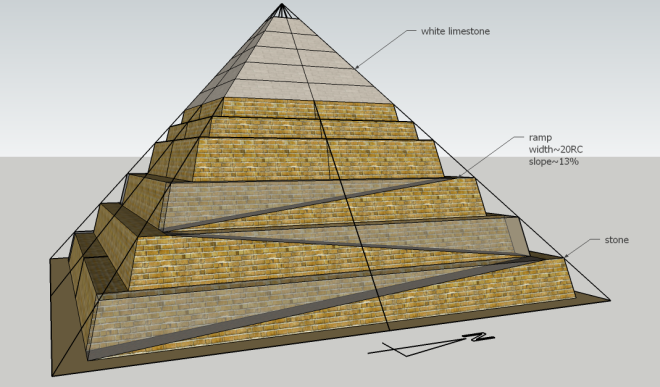Is it better to lift or pull stones ?
In order to raise a mass at a given height H, is it more efficient to use a soft ramp (7°), a normal ramp (11°) or a strong ramp (26°) ? The answer to this question will be useful to explain building of the Giza pyramids.
Posing the problem
In order to raise a mass at an height H, the more the angle increases, the more the force to Apply is important and we need more workers to pull the mass with same effort. On the other hand, the raising distance is reduced. Then for a fixed number of workers, how should we use them to raise faster the mass at a given height ? Should we pull more masses on a longer distance or less masses on a shorter distance with go back ?
Solving the problem
Because of friction forces, the work W=F.D is non conservative. Then, in order to furnish the same power E whatever the path (a or b), we have: E=W/T=cte with T the time to raise mass.
E=Wa/Ta=Wb/Tb
Ta=Tb.Wa/Wb=Tb.FaDa/FbDb with Fa=P[sina+ucosa], Fb=P[sinb+ucosb] Da=H/sina, Db=H/sinb
Ta=zTb with z=[sinb/sina][sina+ucosa]/[sinb+ucosb]
Studying z
z represents the time ratio between cases angle a and angle b, it is too the ratio of masses and Energy: E=Wa/Ta=Wa/zTb=Wb/Tb then Wa=zWb
z>1 always, whatever the friction coefficient u and whatever the angle b, b>a
Concrete example
Realistic example obtained by comparing slopes a=7° and b=26° with u=0.5. The force or worker ratio is F(26°,0.5)/F(7°,0.5)=1.43. The distance ratio is sin(7)/sin(26)=1/3.6 and z=3.6/1.43=2.5. If we have 1430 workers, with 100 workers needed to raise a 5T block, in 10 travels we will raise 143 blocks of 5T that is 715T. In case of a 26° slope, 10 groups of 143 workers will be needed to raise 50T per travel. There will be 36 travels (10*3.6), the workers will raise finally 1800T (50*36).
Extreme case where b=90°
This is the shaft case studied by Peter C. Sundt in 2007 : he gives the formula of the hauling energy:
Wa=zWb=z.P.H where P is the weight and z=1+u/tana
Peter C. Sundt showed that in terms of energy it is better to use a shaft than a ramp. So why considering an elevator starting above 45m and not on ground level? He gave two questionable explanations : ramp lengths exceeding the km, and materials going into the ramp more than into the partial pyramid.
Conclusion
In 2007, Peter C. Sundt makes for the second time a compromise between ramps theories and lifting theories (before Jean Kerisel in 1991: « Les pyramides à travers les âges »). Concerning this aspect, I share same conclusion as him : use only ramps at lower levels and lift at upper levels. However Peter C. Sundt considers only one central elevator which is not enough, because there can’t be more than one load per elevator in contrary to ramps.
Following illustration considers massive with ~9 and ~18m height (35RC):
